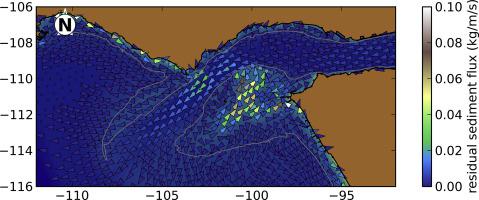Marine Geology ( IF 2.6 ) Pub Date : 2021-07-30 , DOI: 10.1016/j.margeo.2021.106590 A.B. Fortunato 1 , P. Freire 1 , B. Mengual 2 , X. Bertin 2 , C. Pinto 3 , K. Martins 4 , T. Guérin 5 , A. Azevedo 1

|
The morphological evolution of the Tagus estuary inlet in the last century is analyzed in order to characterize its dynamics, explain its behavior and anticipate its future evolution. First, the evolution is characterized through a literature review, complemented by new data analyses. This review synthesizes the present understanding of the inlet's dynamics and highlights some key questions that remain unanswered. To address these questions, a 2DH process-based morphodynamic model is implemented and validated, and then used to refine the previous understanding of the inlet's dynamics. A new conceptual model, which highlights a seasonal behavior of the inlet's morphodynamics, is proposed. During winter time, the residual sediment transport is directed seaward along the navigation channel, towards the inlet mouth along the beaches adjacent to the inlet, and towards the estuary over the southern part of the ebb delta (Cachopo Sul). During the maritime summer, residual sediment fluxes are approximately half those occurring during winter. The relative importance of tidal flows increases, leading to sediment fluxes directed towards the southwest over the Cachopo Sul. The sediment deposits formed during the summer can be mobilized under specific wave conditions and transported to the northern stretch of the beaches to the south of the inlet. A positive feedback between the erosion of the Cachopo Sul – or, similarly, sea level rise – and the sediment fluxes over this bank suggests that the evolution of the bank observed during the last decades will continue in the foreseeable future.
中文翻译:

塔霍河口入海口沉积物动力学和形态演化
分析了上个世纪塔霍河口入口的形态演变,以表征其动态、解释其行为并预测其未来演变。首先,演变的特点是通过文献综述,辅以新的数据分析。这篇综述综合了目前对入口动力学的理解,并突出了一些仍未得到解答的关键问题。为了解决这些问题,实施并验证了基于 2DH 过程的形态动力学模型,然后用于完善先前对入口动力学的理解。提出了一个新的概念模型,它突出了入口形态动力学的季节性行为。在冬季,残余泥沙沿航道向海输送,沿着靠近入口的海滩朝向入口口,以及朝向落潮三角洲南部(Cachopo Sul)的河口。在海洋夏季,残余沉积物通量大约是冬季发生的一半。潮汐流的相对重要性增加,导致在 Cachopo Sul 上向西南方向的沉积物通量。夏季形成的沉积物可以在特定的波浪条件下流动,并输送到入口以南的海滩北段。Cachopo Sul 的侵蚀——或类似地,海平面上升——与该河岸上的沉积物通量之间的正反馈表明,在可预见的未来,过去几十年观察到的河岸演变将继续。并朝向退潮三角洲(Cachopo Sul)南部的河口。在海洋夏季,残余沉积物通量大约是冬季发生的一半。潮汐流的相对重要性增加,导致在 Cachopo Sul 上向西南方向的沉积物通量。夏季形成的沉积物可以在特定的波浪条件下流动,并输送到入口以南的海滩北段。Cachopo Sul 的侵蚀——或类似地,海平面上升——与该河岸上的沉积物通量之间的正反馈表明,在可预见的未来,过去几十年观察到的河岸演变将继续。并朝向退潮三角洲(Cachopo Sul)南部的河口。在海洋夏季,残余沉积物通量大约是冬季发生的一半。潮汐流的相对重要性增加,导致在 Cachopo Sul 上向西南方向的沉积物通量。夏季形成的沉积物可以在特定的波浪条件下流动,并输送到入口以南的海滩北段。Cachopo Sul 的侵蚀——或类似地,海平面上升——与该河岸上的沉积物通量之间的正反馈表明,在可预见的未来,过去几十年观察到的河岸演变将继续。残余沉积物通量大约是冬季发生的一半。潮汐流的相对重要性增加,导致在 Cachopo Sul 上向西南方向的沉积物通量。夏季形成的沉积物可以在特定的波浪条件下流动,并输送到入口以南的海滩北段。Cachopo Sul 的侵蚀——或类似地,海平面上升——与该河岸上的沉积物通量之间的正反馈表明,在可预见的未来,过去几十年观察到的河岸演变将继续。剩余沉积物通量大约是冬季发生的一半。潮汐流的相对重要性增加,导致在 Cachopo Sul 上向西南方向的沉积物通量。夏季形成的沉积物可以在特定的波浪条件下流动,并输送到入口以南的海滩北段。Cachopo Sul 的侵蚀——或类似地,海平面上升——与该河岸上的沉积物通量之间的正反馈表明,在可预见的未来,过去几十年观察到的河岸演变将继续。夏季形成的沉积物可以在特定的波浪条件下流动,并输送到入口以南的海滩北段。Cachopo Sul 的侵蚀——或类似地,海平面上升——与该河岸上的沉积物通量之间的正反馈表明,在可预见的未来,过去几十年观察到的河岸演变将继续。夏季形成的沉积物可以在特定的波浪条件下流动,并输送到入口以南的海滩北段。Cachopo Sul 的侵蚀——或类似地,海平面上升——与该河岸上的沉积物通量之间的正反馈表明,在可预见的未来,过去几十年观察到的河岸演变将继续。











































 京公网安备 11010802027423号
京公网安备 11010802027423号